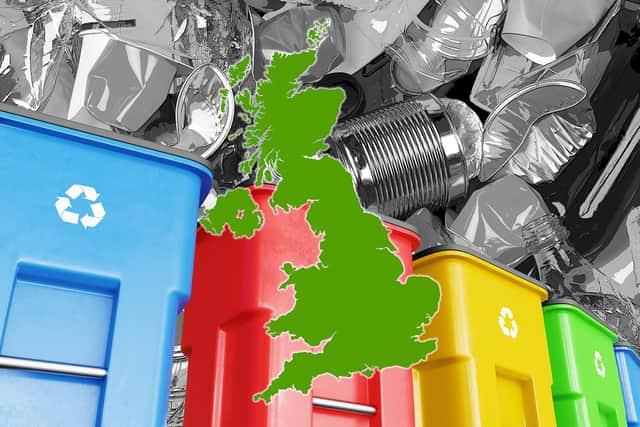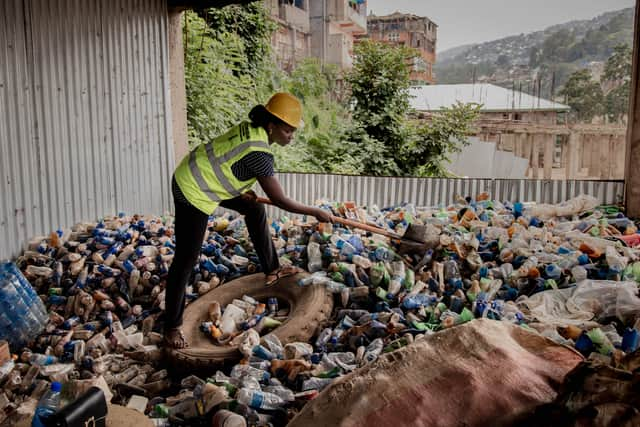How much does the UK recycle? The regions with the best rates, government targets - and is recycling worth it
This article contains affiliate links. We may earn a small commission on items purchased through this article, but that does not affect our editorial judgement.
and live on Freeview channel 276
In the UK, recycling waste from households has increased over the years, with Wales scoring the best in 2019 and Scotland ranked at the bottom.
For England, its recycling rate has steadily increased but it failed to meet its target to recycle 50% of waste from households by 2020 - only reaching 44%.
Advertisement
Hide AdAdvertisement
Hide AdThe Covid-pandemic has had an impact on recycling rates due to service disruptions and closures, but how much does the UK recycle on average every year and is recycling actually worth it?
NationalWorld uses figures and data sourced from WasteDataFlow published by the Department for Environment, Food and Rural Affairs (DEFRA) to reveal how good the UK is at recycling its waste.


How is waste from households measured?
Firstly let’s take a look at how waste from households is measured.
Waste from Households (WfH) is the agreed UK measure used to report household recycling.
WfH includes waste from:
- Regular household collection
- Civic amenity sites
- ‘Bulky waste’
- ‘Other household waste’.
WfH excludes waste from:
- Street cleaning/sweeping
- Gully emptying
- Separately collected healthcare waste
- Soil, Rubble, Plasterboard & Asbestos waste
Advertisement
Hide AdAdvertisement
Hide AdHousehold waste is broader than WfH and includes waste from street bins, street sweepings, and parks and grounds.
It does not include metals from incinerator bottom ash.
Local authority collected waste is another measure broader than WfH.
It is all waste within the remit of local authorities including household waste plus other non-household waste collected by the authorities - including from commercial and industrial sources.
How much does the UK recycle?
The recycling rate for WfH increased in all UK countries in 2019, rising from 45% in 2018 to 46.2% in 2019, according to DEFRA figures.
Advertisement
Hide AdAdvertisement
Hide AdThe overall recycling rate for England was 45.5%, compared with 50.6% in Northern Ireland, 44.9% in Scotland, and 56.4% in Wales.
The recycling rate is the percentage of local authority municipal waste that was reused, recycled, or composted.
Loading....
Wales scored the best for recycling waste from households, whereas Scotland ranked the worst.
‘Recycling and other recovery’ was the most common final waste treatment type in the UK, accounting for 108.4 million tonnes (50.4%) in 2018.
Advertisement
Hide AdAdvertisement
Hide AdAround two thirds of ‘Recycling and other recovery’ is recovery of mineral wastes and soils from the construction, demolition and excavation sector.
The remainder is predominantly recycling (glass, plastic, metal, wood, composting etc.) but also includes some non-recycling activities that are not captured elsewhere, e.g. wood used for biomass.
However, landfill was the second most used waste treatment in the UK in 2018 - with 50.8 million tonnes of waste disposed.
How much does England recycle?
In England, the WfH recycling rate increased from 41.2% in 2010 to 45.5% in 2019, DEFRA figures show.
Advertisement
Hide AdAdvertisement
Hide AdIn 2020, the recycling rate was 44% - down 1.5 percentage points from 2019.
This recycling rate meant that England had not met its target to recycle 50% of all waste from households.
Overall, in 2020, total ‘waste from households’ increased to 22.6 million tonnes from 22.1 million tonnes in 2019, due to more people spending time at home during the Covid-19 pandemic.
In the same year the total amount of ‘waste from households’ recycled decreased.
Loading....
Advertisement
Hide AdAdvertisement
Hide AdIn 2019 10.1 million tonnes of waste from households was recycled, but in 2020 this dropped to 9.9 million tonnes.
This has been attributed to service disruptions, for instance the closure of Household Waste and Recycling Centres (HWRCs) due to the pandemic.
Recycling collected at HWRCs usually makes a significant contribution to overall recycling tonnages from households.
As a result of the closures and limited reopening, tonnages of organics and dry recycling collected at HWRCs were around 0.8 million tonnes lower in 2020.
What England authority recycles the most?
Advertisement
Hide AdAdvertisement
Hide AdIn the financial year 2020/21, total local authority managed waste increased by 1.3% 25.9 million tonnes - of which 10.7 million tonnes was sent for recycling, according to DEFRA.
This was a decrease of 0.2 million tonnes (2.2%) compared to the 2019/20 financial year.
The data shows the proportion of all local authority collected waste sent for recycling and composting in 2020/21.
In England, 10.7 million tonnes (41.4%) of local authority collected waste was sent for recycling in 2020/21.
Loading....
Advertisement
Hide AdAdvertisement
Hide AdThe region that sent the largest proportion of local authority collected waste to recycling was the South West, which sent 1.3 million tonnes (48.3%).
The region that sent the smallest proportion of waste to recycling was London, which sent 1.1 million tonnes (29.9%).
How much does Wales recycle?
Separate data published by the Welsh Government shows Wales’ recycling rate increased from 65.1% in 2019/20 to 65.4% in 2020/21, a new record high.
Thirteen of the 22 local authorities in Wales reported an increase in their recycling rate compared to the previous year.
How much does Northern Ireland recycle?
Advertisement
Hide AdAdvertisement
Hide AdNorthern Ireland’s councils collected 1,031,169 tonnes of waste during 2020/21 which was 3.2% higher than that collected in 2019/20, according to figures published by the Department of Agriculture, Environment and Rural Affairs Northern Ireland.
During 2020/21, 50.0% of waste collected by councils was sent for recycling, 1.1 percentage points lower than the recycling rate for 2019/20.
Belfast recycled the most amount of waste in the financial year 2020/21, with 71,246 tonnes of waste recycled.
Loading....
The council with the lowest amount of recycled waste was Fermanagh and Omagh, with 27,880 tonnes.
How much does Scotland recycle?
Advertisement
Hide AdAdvertisement
Hide AdFigures published by the Scottish Government show that household waste recycling rate was 44.9% in 2019 and it was the third consecutive year that more Scottish waste was recycled.
Scotland has a national target to achieve a 70% recycling rate by 2025.
Additional figures published by the Scottish Environment Protection Agency (SEPA) shows Orkney and Shetland are the worst local authorities in Scotland in terms of recycling with East Renfrewshire recycling the most followed by Moray and Angus.
Shetland recycled 17.1% of household waste, with Orkney at 18.8%.
Advertisement
Hide AdAdvertisement
Hide AdMeanwhile at the top of the board was East Renfrewshire with 67.8% of household waste recycled, Angus at 59.1% followed by Moray at 59%.
What are the UK’s recycling targets?
DEFRA figures show the UK generated 222.2 million tonnes of total waste in 2018, with England responsible for 84% of the UK total.
Here are the UK’s targets:
- by 2025, the preparing for re-use and the recycling of municipal waste shall be increased to a minimum of 55% by weight
- by 2030, the preparing for re-use and the recycling of municipal waste shall be increased to a minimum of 60% by weight
- by 2035, the preparing for re-use and the recycling of municipal waste shall be increased to a minimum of 65% by weight
The Government has also created a Collection and Packaging Reforms which will reduce confusion around recycling, provide higher quality recyclate for reprocessors, increase recycling rates and reduce unnecessary and difficult-to-recycle packaging.
Meanwhile Downing Street has rolled out separate weekly food waste collections for households to help overall recycling rates in England.
Advertisement
Hide AdAdvertisement
Hide AdGovernment has committed to providing £295 million of funding by 2025 to enable local authorities in England to prepare to introduce separate food waste collections for all households.
Is it imperative to recycle - does it make a difference?
Professor Richard Thompson OBE, Head of the International Marine Litter Research Unit at the University of Plymouth, explained to NationalWorld the importance of recycling on helping families be able to “do their bit” but also pinpointed what needs to be changed to make it a more effective means to safeguarding our planet.
“If recycling is likely to be the best end of life option for a product then, quite simply, we need to make sure products are designed with end of life recycling in mind,” he said.
Professor Thompson added: “If something is labelled as ‘recyclable’ there is no 100% guarantee it will be recycled, even if it reaches a recycling waste stream.
Advertisement
Hide AdAdvertisement
Hide Ad“And that is a challenge we need to overcome for consumers to be fully confident their positive intentions are having the desired positive results.”


The impact of plastic “has grown exponentially,” he said, “we know it can result in economic challenges and can harm the environment, the wildlife living within it, and our own mental and physical wellbeing.”
“And yet, broadly speaking, the solutions to address this issue are the same as they were in the early 1990s,” he added.
Meanwhile Scott Butler, executive director of Material Focus, presses the importance of recycling and particularly for electrical products.
He said: “Producing electricals creates carbon emissions.
Advertisement
Hide AdAdvertisement
Hide Ad“Recycling our old electricals would cut as much CO2 as taking 1.3 million cars off the road as 527 million items are hoarded in the UK.”
Recycling these types of materials could hugely impact the environment and carbon levels, but “there needs to be more information on recycling,” he added.
Material Focus has set up a Recycle Your Electricals campaign to tackle waste electricals in the UK which is the fastest growing waste stream globally.
A message from the editor:
Thank you for reading. NationalWorld is a new national news brand, produced by a team of journalists, editors, video producers and designers who live and work across the UK. Find out more about who’s who in the team, and our editorial values. We want to start a community among our readers, so please follow us on Facebook, Twitter and Instagram, and keep the conversation going. You can also sign up to our email newsletters and get a curated selection of our best reads to your inbox every day.
Comment Guidelines
National World encourages reader discussion on our stories. User feedback, insights and back-and-forth exchanges add a rich layer of context to reporting. Please review our Community Guidelines before commenting.
